Promoting Better Connections with Children in Foster Care: Three Systemic Strategies


By Tanya Collins and Nanmathi Manian
Children in foster care settings often face a greater number of day-to-day challenges than others in their peer group, including challenges related to learning outcomes in school. Conversely, those who demonstrate more favorable outcomes tend to have had at least one stable, committed relationship with a supportive adult. In the absence of such a relationship, schools can step in to help create a buffer between the child and developmental disruption so that the child has the space to develop skills needed to thrive.
In this short blog post, we present three strategies that districts and schools can employ to support systems that can promote meaningful connections for children in foster care.
Strategy One: Collaborate with other stakeholders
Just as interagency collaboration is critical to the provision of appropriate student support and interventions, so too can it serve as a means of addressing the unique needs of children in foster care. Building collaborative systems will help educators to better understand the needs of these students as well as ensuring that districts and schools engage with other stakeholders in their best interest. Districts and schools can begin this process by:
• Creating opportunities for discussion concerning the roles and responsibilities of those involved in educational planning. Consider advocating for an asset-based approach to planning, one that assumes that every student has the potential and motivation to grow and produce better learning outcomes.
• Holding regular, informal information-sharing sessions with an education team of school staff and staff from other agencies involved with the child to discuss the child’s educational progress and needed resources and services. Key players might include caseworkers, teachers, school-based mental health professionals, juvenile probation officers, special education liaisons, and mentors, among others.
Strategy Two: Champion systems that eliminate barriers and support successful school transitions
Administrators can support student’s feelings of connectedness by creating systems in which all students from foster care feel welcomed, cared for, and supported, even as they transition into and from the physical school building. Schools and districts can adopt policies that ease the school transitions of children in foster care by:
• Ensuring immediate enrollment even when students are missing the required educational, health, or special education records.
• Expediting the transference of school records when a child relocates to another school. Doing so will make certain that the child is quickly enrolled in the new school, while also identifying any special services or resources the child requires so that there are no gaps in services.
• Convening an educational planning meeting to determine the individual needs of the child and arranging a special education meeting if the child needs to receive services immediately through an IEP or 504 plan.
“It really affected me—I would either be ahead of a curriculum or too far behind. They were never quite sure what class I was supposed to be in — I’d get settled in one class and [when the transcripts arrived] then they would change my schedule and my classes.” – Student who attended nine different schools from elementary through high school
Strategy Three: Build networks of support
Every child benefits from having advocates, a team of caring and committed individuals partnering to advocate on their behalf. For students in foster care settings, the district and the school can promote these partnerships by engaging in conversation with the child’s parent/foster parent/caregiver and the youth themselves. Doing so can help ensure that schools are serving the diverse developmental needs of each individual learner. Here are a few strategies to keep in mind as you develop these partnerships:
• Establish a foster care support group for both foster children and foster parents in your district. Identify a school staff person (e.g., counselor, teacher, social worker) to whom the youth or parent can talk to about any problems or concerns.
• Maintain an open line of communication with the child’s parent/foster parent/caregiver. Inform the caseworker of special issues that impact the child’s functioning or educational progress.
By implementing these steps, districts can support school systems for foster care students that provide opportunities for developing these relationships, thereby addressing a very real and persistent student need and helping to ensure that they can succeed in school and beyond.




